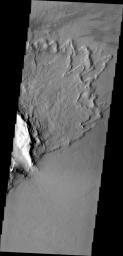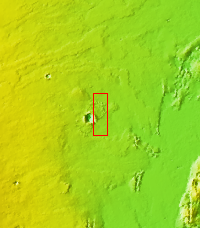
|
Butterfly Ejecta
- Click the image above for a larger view
- Full-Res JPEG (1327 x 2773) (342.6 kB)
- Full-Res TIFF (1327 x 2773) (3.7 MB)
Caption:
"Butterfly" ejecta is the name given when a crater has two lobes of ejecta on opposite sides, with little or no ejecta between the lobes. It is thought that this ejecta pattern is created by a low angle impact. The lack of ejecta indicates the direction of the impact, with the two lobes formed perpendicular to the incoming direction. This VIS image shows half of a crater with "butterfly" ejecta.
Orbit Number: 47277 Latitude: 9.25753 Longitude: 279.824 Instrument: VIS Captured: 2012-08-10 23:48
Background Info:
Please see the THEMIS Data Citation Note for details on crediting THEMIS images.
NASA's Jet Propulsion Laboratory manages the 2001 Mars Odyssey mission for NASA's Science Mission Directorate, Washington, D.C. The Thermal Emission Imaging System (THEMIS) was developed by Arizona State University, Tempe, in collaboration with Raytheon Santa Barbara Remote Sensing. The THEMIS investigation is led by Dr. Philip Christensen at Arizona State University. Lockheed Martin Astronautics, Denver, is the prime contractor for the Odyssey project, and developed and built the orbiter. Mission operations are conducted jointly from Lockheed Martin and from JPL, a division of the California Institute of Technology in Pasadena.
Cataloging Keywords:
| Name | Value | Additional Values |
|---|---|---|
| Target | Mars | |
| System | ||
| Target Type | Planet | |
| Mission | 2001 Mars Odyssey | |
| Instrument Host | Mars Odyssey | |
| Host Type | Orbiter | |
| Instrument | Thermal Emission Imaging System (THEMIS) | |
| Detector | ||
| Extra Keywords | Crater, Grayscale, Impact, Thermal | |
| Acquisition Date | ||
| Release Date | 2012-10-18 | |
| Date in Caption | 2012-08-10 | |
| Image Credit | NASA/JPL/ASU | |
| Source | photojournal.jpl.nasa.gov/catalog/PIA16327 | |
| Identifier | PIA16327 | |

